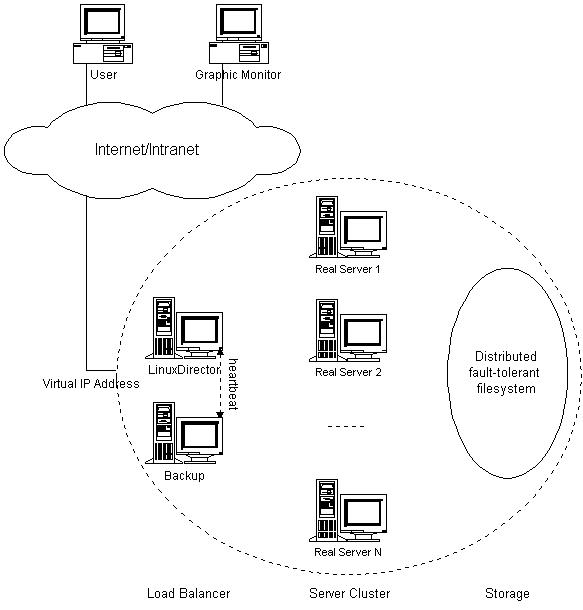- 浏览: 147423 次
-

文章分类
最新评论
-
yajie:
写的一知半解,丁你个费!
数据挖掘(协同过滤、关联推荐、聚类分类)一些资料 -
xo_knight:
7.0有什么新的功能和改变吗
MyEclipse7.0相关备忘 -
kjj:
# <interceptor-ref name=&quo ...
Struts2 Action方法执行两次的问题?model-driven奇怪现象 -
xuhuasen:
我工程只是在ajax异步发送action方法时才执行了两次,检 ...
Struts2 Action方法执行两次的问题?model-driven奇怪现象 -
azure1898:
可能是你的提交按钮是submit类型,并且在按钮的onclic ...
Struts2 Action方法执行两次的问题?model-driven奇怪现象
集群技术主要分为三大类:
- 高可用性(High Available Cluster),例:Linux-HA
- 负载均衡(Load balancing Cluster),例:LVS、MOSIX
- 高性能计算(High Performance Computing),例:Beowulf
我们这里使用RedHat AS 3.x,LVS,Linux-HA,Ldirectord,构造一个高可用的负载均衡集群系统。如图:

各层的作用:
|
各服务器IP分配:
| Virtual IP: | 192.168.136.10 |
| Load Balancer: | 192.168.136.11 |
| Backup: | 192.168.136.12 |
| Real Server 1: | 192.168.136.101 |
| Real Server 2: | 192.168.136.102 |
| Real Server 3: | 192.168.136.103 |
IPVS
IPVS是LVS集群系统的核心软件,它的主要作用是:
|
IPVS的负载均衡机制有三种,这里使用IP Tunneling机制:
|
IPVS的负载调度算法有十种:
- 轮叫(Round Robin)
- 加权轮叫(Weighted Round Robin)
- 最少链接(Least Connections)
- 加权最少链接(Weighted Least Connections)
- 基于局部性的最少链接(Locality-Based Least Connections)
- 带复制的基于局部性最少链接(Locality-Based Least Connections with Replication)
- 目标地址散列(Destination Hashing )
- 源地址散列(Source Hashing)
- 最短期望延迟(Shortest Expected Delay)
- 无须队列等待(Never Queue)
IPVS安装主要包括三方面:
|
关于如何编译内核请参考其他文档,这里使用从UltraMonkey下载的已编译好的内核。
在Load Banlancer、Backup和Real Server上使用同一内核,IPVS和ARP hidden都已编译在这个内核里:
wget http://www.ultramonkey.org/download/2.0.1/rh.el.3.0/RPMS/mkinitrd-3.5.13-1.um.1.i386.rpm
wget http://www.ultramonkey.org/download/2.0.1/rh.el.3.0/RPMS/kernel-2.4.21-27.0.2.EL.um.1.i686.rpm
wget http://www.ultramonkey.org/download/2.0.1/rh.el.3.0/RPMS/kernel-smp-2.4.21-27.0.2.EL.um.1.i686.rpm
rpm -Fhv mkinitrd-3.5.13-1.um.1.i386.rpm
rpm -Fhv kernel-2.4.21-27.0.2.EL.um.1.i686.rpm
在Load Banlancer和Backup上安装IPVS管理软件:
|
wget http://www.linuxvirtualserver.org/software/kernel-2.4/ipvs-1.0.10.tar.gz tar zxf ipvs-1.0.10.tar.gz chkconfig --del ipvsadm |
配置IPVS(/etc/sysconfig/ipvsadm),添加Real Server:
| -A -t 192.168.136.10:80 -s rr -a -t 192.168.136.10:80 -r 192.168.136.11:80 -i -a -t 192.168.136.10:80 -r 192.168.136.12:80 -i
-a -t 192.168.136.10:80 -r 192.168.136.101:80 -i |
相关链接:
| Kernel:http://www.kernel.org/ IPVS和IPVSadm:http://www.linuxvirtualserver.org/software/ipvs.html ARP hidden:http://www.ssi.bg/~ja/#hidden |
注意事项:
| 1. Kernel,IPVS,IPVSadm,ARP hidden之间的版本必须对应。 2. 自己编译内核时,从http://www.kernel.org/下载标准内核源文件,不要使用发行版的内核源文件。 3. Kernel 2.4.28和2.6.10及以上版本已内置IPVS,有些Linux发行版也在其内核里编译了IPVS。 4. ARP hidden可以用arp_ignore/arp_announce或者arptables代替 |
HeartBeat
HeartBeat是Linux-HA的高可用性集群软件,它的主要作用是:
|
HeartBeat串口线连接测试方法:
| 在Load Balancer上:cat < /dev/ttyS0 在Backup上:echo hello > /dev/ttyS0 |
修改主机名(/etc/hosts):
| 127.0.0.1 localhost.localdomain localhost 192.168.136.11 loadbalancer
192.168.136.12 backup |
安装:
| groupadd -g 694 haclient useradd -u 694 -g haclient hacluster rpm -ivh /mnt/cdrom/RedHat/RPMS/glib2-devel-* wget http://www.packetfactory.net/libnet/dist/libnet.tar.gz tar zxf libnet.tar.gz
cd libnet cd heartbeat-1.99.4 chkconfig --add heartbeat |
主配置文件(/etc/ha.d/ha.cf):
| #debugfile /var/log/ha-debug logfile /var/log/ha-log logfacility local0 keepalive 2 deadtime 30
warntime 10 # 当主节点恢复后,是否自动切回 # 输入"grep misc /proc/devices"(应为10),输入"cat /proc/misc | grep watchdog"(应为130)。 node backup respawn root /usr/lib/heartbeat/ipfail #apiauth ping gid=haclient uid=alanr,root |
资源文件(/etc/ha.d/haresources):
| loadbalancer lvs IPaddr::192.168.136.10/24/eth0 ipvsadm ldirectord |
认证文件(/etc/ha.d/authkeys),选取一种认证方式,这个文件的权限必须是600:
| auth 1 1 crc #2 sha1 sha1_any_password #3 md5 md5_any_password |
相关链接:
| Linux-HA:http://www.linux-ha.org
|
ldirectord
安装HeartBeat过程中,已经自动安装了Ldirectord,它的作用是:
|
配置(/etc/ha.d/ldirectord.cf):
| # Global Directives checktimeout=3
checkinterval=1 # A sample virual with a fallback that will override the gobal setting virtual=192.168.136.10:80 real=192.168.136.103:80 ipip virtualhost=www.funbsd.net |
在每个Real Server的中添加监控页:
| echo "Test Page" >> /var/www/html/test.html |
Patch
在启动集群系统之前,我们认为包括Load Balancer和Backup在内的所有服务器都是Real Server。
在服务器上添加以下脚本/etc/init.d/tunl,用来配置tunl端口,应用arp补丁:
| #!/bin/sh # chkconfig: 2345 70 10 # description: Config tunl port and apply arp patch
VIP=192.168.136.10 . /etc/rc.d/init.d/functions case "$1" in echo 1 > /proc/sys/net/ipv4/ip_forward stop) ;; |
如果有多个Virutal IP,可以使用tunl0:0,tunl0:1...。
|
chmod 755 /etc/init.d/tunl |
在Load Balancer和Backup上,这个脚本的启动级必须先于heartbeat,关闭级必须后于heartbeat。
Scripts
在HeartBeat资源文件(/etc/ha.d/haresources)中定义了实现集群所需的各个软件的启动脚本。
这些脚本必须放在/etc/init.d或者/etc/ha.d/resource.d目录里,启动顺序不能变:
| loadbalancer lvs IPaddr::192.168.136.10/24/eth0 ipvsadm ldirectord |
IPaddr的作用是启动Virutal IP,它是HeartBeart自带的一个脚本。
ipvsadm的作用是在启动的时候把所有Real Server加入群中。
ldirectord的作用是启动ldirectord监控程序。
lvs的作用是为启动Load Balancer做准备,关闭tunl端口,取消arp补丁:
| #!/bin/sh # chkconfig: 2345 90 10 # description: Preparing for Load Balancer and Real Server switching
VIP=192.168.136.10 . /etc/rc.d/init.d/functions case "$1" in echo 1 > /proc/sys/net/ipv4/ip_forward ifconfig tunl0 $VIP netmask 255.255.255.255 broadcast $VIP up ;; |
| chmod 755 /etc/ha.d/resource.d/lvs |
启动集群系统:
| /etc/init.d/heartbeat start |
发表评论
-
iptables封讯雷
2010-07-05 16:06 2366本文转自网络 下载文件最新内核: http://www. ... -
温顾而知新--gcc和vi基本用法
2010-04-15 14:35 1024vi编辑器是所有Unix及Li ... -
yum php 5.1 更新 5.2
2009-06-09 14:04 1208rpm --import http://www.jason ... -
Linux系统管理硬件配置
2009-05-12 15:45 1265常用命令整理如下:查� ... -
nagios二 客户端程序的安装
2009-01-12 18:46 2641要监视客户机的本地信息需要用到nrpe这个程序 NRPE的原理 ... -
nagios监控一(主程序的安装)
2009-01-12 18:45 1709Nagios 是一个开放源代码的主机、服务和网络监控平台,有各 ... -
lighttpd的启动脚本
2009-01-12 18:43 3462参考http://trac.lighttpd.net/tra ... -
lighttpd+tomcat+squid3.0
2009-01-12 18:41 1798我这里主要是用lighttpd来代替已有的apach ... -
squid3.0反向代理
2009-01-12 18:39 1266apache(81端口)+squid(80端口)(apach ... -
Linux Iptables语法
2009-01-12 18:37 1174语法 1. 对链的操作 建� ... -
nmap使用详解
2009-01-12 18:35 1039nmap使用详解 nm ... -
网络监控工具:IPTraf
2009-01-12 18:30 40632.使用IPTraf 2.1 ... -
优化squid配置
2009-01-12 18:29 1208#设置运行时的用户和组权限 cache_effective_u ... -
squid 基本配置
2009-01-12 18:27 1299配置命令configure有很多选项,如果不清楚可先用“-he ... -
linux 内核升级
2009-01-12 15:44 2046一 准备工作1 查看linux内核版本#uname -a2 下 ... -
sarg对squid的日志流量分析报表(按小时,天,周生成)
2009-01-12 15:41 34571.SARG介绍 SARG的全称是:Squid Analys ... -
Linux下Java的安装及环境配置
2009-01-12 15:40 1761在sun官网下载JDK 6(jdk-6u7-linux-i5 ... -
linux集群
2009-01-12 15:33 1206集群系统主要就2种: 系统:Centos5.0 集群软件: ...





相关推荐
LVS DR 模式总结详细笔记文档 LVS(Linux Virtual Server)是一种基于 Linux 的负载均衡解决方案,能够将incoming请求分布到多个后端服务器上,以提高系统的可扩展性和高可用性。在 DR 模式下,LVS 可以与 ...
LVS 集群使用 DR 模式,1 个 DS(Director Server),2 个 RS(Real Server)。路由只有一个,RouteA=RouteB。上图中的 GW 为网关(GateWay),VIP 为 LVS 中的虚拟 IP。 二、服务器配置 在配置服务器时,需要修改...
**LVS DR模式详解** LVS(Linux Virtual Server)是一种基于IP层的负载均衡技术,DR(Direct Routing)模式是其工作模式之一,它通过直接路由的方式实现负载均衡。在这个案例环境中,我们将深入理解DR模式的搭建...
实验2 LVS DR模式实现负载均衡.md
LVS-DR 模式原理、流程特点及搭建 LVS-DR 模式是 Load Balancer 的一种实现方式,它可以将incoming请求分配到多个 Real Server 上,以提高系统的可用性和性能。LVS-DR 模式的核心思想是使用 Director 服务器来分配...
### Linux LVS的DR模式详解 #### 一、概述 Linux Virtual Server (LVS) 是一个基于 Linux 内核的高性能负载均衡解决方案,它能够通过调度算法将客户端请求分发到多个后端服务器(Real Server),从而实现负载均衡...
### LVS/NAT与LVS/DR模式集群的概述与配置 #### 一、集群及其重要性 **集群**的概念是指一组通过高速网络互连的计算单元,它们以单一系统的模式进行管理,对外提供一致的服务体验。集群技术的核心优势在于其能够...
LVS VIP 脚本,用在后端的Nginx 上面,每台Nginx上都要运行。
### LVS负载均衡DR模式安装调试介绍 #### 一、概述 在《第三讲LVS负载均衡DR模式安装调试介绍》这一章节中,主要讲解了如何在特定的网络环境中搭建并配置LVS(Linux Virtual Server)负载均衡系统,特别是DR...
**LVS负载均衡DR模式详解** LVS(Linux Virtual Server)是基于Linux内核的高性能负载均衡解决方案,它能够将网络请求分发到多个后端服务器,以实现高可用性和可扩展性。DR(Direct Routing)模式是LVS中的一种工作...
LVS源码分析 LVS(Linux Virtual Server)是一种开源的负载均衡软件,能够将incoming请求分配到多个real server上以提高系统的可扩展性和可靠性。下面是LVS源码分析的总结。 ip_vs_conn 结构体 ip_vs_conn结构体...
Redhat Linux 6 操作系统LVS_DR模式配置的详细文档,按照文档的部署和配置可实现 LVS_DR模式的负载均衡。
Keepalived+LVS-DR 模式配置高可用负载均衡集群是当前网络应用中一种常见的架构模式。该模式通过 Keepalived 和 LVS-DR two技术结合,实现了高可用负载均衡集群的配置和实现。 一、 LVS 网络拓扑图 LVS(Linux ...
LVS需要配置为DR模式,并将后端的多个MySQL从节点加入到虚拟服务中。 - **Apache服务器配置**: Apache服务器位于192.168.18.2,配置了与LVS的通信,确保用户请求能够被正确地转发至LVS,再由LVS根据规则分配给...
**LVS DR模式** 1. **网络结构**:DR模式下,VIP(Virtual IP)与所有Real Server在同一网络段内。 2. **工作原理**: - 客户端向VIP发送请求,VIP依据调度算法选择合适的Real Server。 - VIP修改请求包的MAC地址...
LVS支持三种常见的工作模式:NAT模式、DR模式(Direct Routing模式)和IP Tunneling模式。本文将重点介绍LVS通过DR模式实现后台网站服务的代理。 在DR模式下,LVS作为负载均衡器,它并不修改数据包的源或目标IP地址...
其中,DR模式由于其实现简单且性能较高,在实际部署中被广泛采用。 #### 二、LVS DR模式详解 LVS的DR模式是通过直接路由的方式来实现负载均衡的。在DR模式下,真实服务器与负载均衡器在同一物理网络上,并且它们的...
### 如何在VMware上部署LVSDR:深入解析与实践指南 #### LVS/DR原理 LVS(Linux Virtual Server)是由章文嵩博士在1998年提出的一种高性能且高度可扩展的分布式服务器解决方案,其核心是将一组真实的服务器透明地...
例如,使用ipvsadm -e命令可以修改LVS集群规则的模式,将其改为DR模式。 1.5 小结 LVS是Linux虚拟服务器的缩写,主要用于实现服务器集群和负载均衡。LVS提供了两种集群模式:LVS-NAT集群和LVS-DR集群。通过使用...
DR模式是LVS中的直接路由模式,它通过修改数据包的目标MAC地址,将流量直接发送到真实服务器,无需经过LVS调度器。这种方式下,所有服务器都拥有相同的外部IP地址,且服务器间需要通过共享的物理网络层连接,确保...